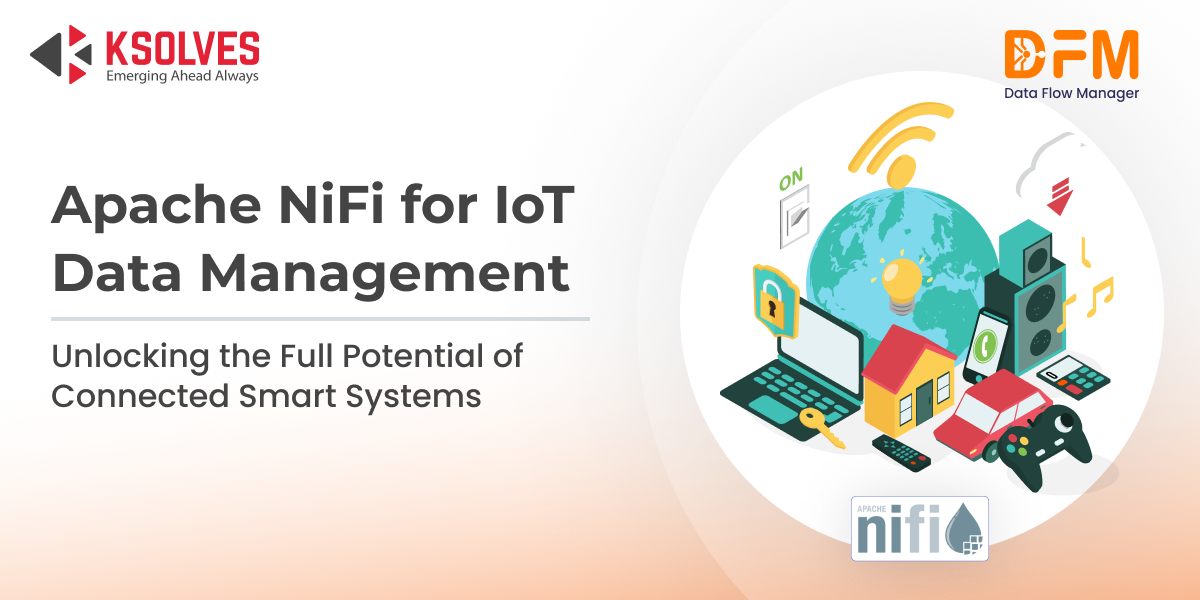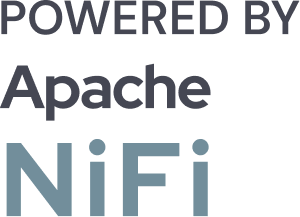Why Businesses Trust Apache NiFi for IoT Data Management in Smart Systems
![]()

The rise of the Internet of Things (IoT) has brought with it a tidal wave of data. From connected refrigerators and wearable devices to smart factories and intelligent transportation systems, the world is becoming increasingly sensorized and interconnected.
According to Statista, there were over 15.14 billion connected IoT devices in 2023, and that number is expected to hit 29.42 billion by 2030. All of these devices constantly generate, transmit, and consume data, creating immense opportunities but also significant challenges for organizations.
To extract value from this data, it must be collected, processed, transformed, routed, and stored efficiently, often in real-time. This is no easy feat, especially when dealing with diverse data sources, protocols, and storage formats. This is where Apache NiFi steps in. It is a powerful open-source data integration tool that was built to handle exactly this kind of complexity, especially in environments like IoT and smart systems.
Why Does IoT Data Management Look Harder?
1. IoT Data is Diverse and Dynamic
IoT data comes in all shapes and sizes, JSON payloads from smart thermostats, XML from vehicle sensors, binary data from PLCs, and CSV logs from smart meters. It’s not just the format; it’s also the velocity (how fast it arrives), volume (how much is collected), and variety (how many different types are involved) that complicate things.
2. Real-time Decisions Demand Real-time Data
From predictive maintenance to traffic light automation, IoT systems often need to process and act on data in real-time or near real-time. Batch processing simply won’t cut it when every millisecond counts.
3. Edge Devices + Cloud Systems = Complexity
IoT architecture often spans edge, on-premise, and cloud environments. Ensuring seamless data movement and transformation across these tiers can be daunting.
4. Security and Compliance Are Critical
With data flying across networks and continents, end-to-end encryption, access control, and auditability are more than best practices – they’re necessities.
Organizations need a solution that can handle all of this. That’s where Apache NiFi shines.
Meet Apache NiFi: The Data Flow Engine Built for Today’s World
Apache NiFi is an open-source platform designed to automate the movement of data between disparate systems. Originally developed by the NSA (yes, that NSA), it was later donated to the Apache Software Foundation and is now a community-driven powerhouse.
What Makes Apache NiFi Unique?
- Drag-and-drop interface for creating and managing data pipelines
- Real-time monitoring and control over each flow
- Backpressure and prioritization to avoid overloading systems
- Built-in processors for routing, transformation, filtering, and enrichment
- Secure by design with TLS, user authentication, and granular access control
- Provenance tracking, so you know where your data came from and what happened to it
NiFi makes it easy to build robust, traceable, and flexible dataflows, which is exactly what IoT and smart systems demand.
Why Apache NiFi is the Perfect Fit for IoT Data Management and Smart Systems
Let’s shed light on how Apache NiFi helps manage IoT data.
1. Seamless Ingestion from a Multitude of IoT Sources
NiFi supports a wide range of protocols out-of-the-box, including MQTT, Kafka, CoAP, HTTP, OPC-UA, and more. Whether you’re collecting data from a smart thermostat, a drone, or a connected vehicle, NiFi can easily tap into the stream.
In industries like manufacturing and energy, where devices often use industrial protocols, NiFi can connect using gateways or protocol converters to ingest data from PLCs or SCADA systems.
Did you know? According to Deloitte, 65% of industrial companies struggle with integrating legacy machine data into modern analytics platforms.
NiFi makes this integration a breeze.
2. Real-Time, Event-Driven Processing
In an IoT world, data loses value quickly. Apache NiFi enables event-based triggers and low-latency processing that ensures decisions are made as data is received.
Whether it’s detecting a faulty component on a production line or adjusting a smart irrigation system based on weather inputs, NiFi’s event-based architecture ensures minimal lag.
3. Smart Data Transformation and Enrichment
Not all data is useful in its raw form. Apache NiFi includes processors to:
- Convert units (e.g., Fahrenheit to Celsius)
- Normalize payloads across different device formats
- Enrich records with metadata (e.g., geolocation, timestamps, device type)
- Aggregate values over a time window (e.g., hourly temperature averages)
This enables downstream analytics systems, like machine learning models or dashboards, to work with clean, structured, and meaningful data.
4. Built for Scale with Distributed Architecture
Apache NiFi is highly scalable. It supports horizontal scaling via clustering, and you can deploy it in various configurations—from a single node on a Raspberry Pi to a distributed architecture on Kubernetes or a cloud platform.
NiFi also offers Site-to-Site (S2S) capabilities, which allow different instances to talk securely and efficiently, making it ideal for hybrid edge-cloud deployments.
5. Edge Processing with Apache MiNiFi
Sometimes, it makes sense to process data at the edge to reduce latency, cut costs, and ensure resilience during network disruptions. That’s where MiNiFi comes in.
Apache MiNiFi is a lightweight version of NiFi designed to run on constrained devices. It can:
- Filter or compress data locally
- Perform initial validation or transformation
- Buffer and forward data to NiFi when connectivity is restored
Perfect for farms, oil rigs, or remote wind turbines where bandwidth is limited and latency is critical.
6. Full Data Lineage and Provenance
Every flowfile in NiFi carries a complete history of its journey. From the time it’s ingested to every transformation, fork, or drop—it’s all tracked.
This provides:
- Compliance assurance (important for industries like healthcare or finance)
- Easier debugging
- Data governance capabilities
7. Effortless Integration with Analytics, Storage & Cloud Tools
Apache NiFi seamlessly connects with:
- Cloud storage (AWS S3, Azure Blob, Google Cloud)
- Big data systems (Hadoop, Hive, HBase)
- Databases (PostgreSQL, MongoDB, MySQL)
- Search engines (Elasticsearch)
- Machine learning frameworks (via REST or Kafka)
This makes it the ideal bridge between raw IoT data and the platforms where insights are generated.
Real-World Use Cases: NiFi in Action
1. Smart Cities
NiFi is used to collect traffic data, control smart lighting, and monitor air quality sensors. Cities like Chicago and Barcelona have invested in NiFi-like architectures for real-time urban management.
2. Industrial IoT
Manufacturers use NiFi to collect and analyze telemetry data from machines, helping them move from preventive to predictive maintenance.
3. Smart Agriculture
Farmers use NiFi to monitor soil moisture, nutrient levels, and weather data—automating irrigation and improving yield forecasts.
4. Energy & Utilities
Utility companies rely on NiFi to manage smart meter data, detect anomalies in consumption, and balance grid loads in real-time.
How Data Flow Manager Enhances IoT Data Management and Smart Systems
While Apache NiFi offers a powerful foundation for managing IoT data, maintaining consistency, version control, and smooth flow promotion across environments (Dev, Staging, Production) can become complex—especially in enterprise IoT ecosystems.
That’s where Data Flow Manager steps in to take your on-premise NiFi-based IoT architecture to the next level.
1. Automated Data Flow Deployment and Promotion Across Environments
IoT data pipelines often go through rigorous testing before hitting production. With Data Flow Manager, you can seamlessly deploy and promote NiFi data flows across Development, QA, and Production environments in minutes – no NiFi UI and controller services.
This ensures:
- Fewer flow configuration errors
- Faster flow deployments
- Flow configuration consistency across environments
2. Version Control Made Easy
Managing dozens (or hundreds) of NiFi data flows in an IoT setup? Data Flow Manager offers integrated version control, enabling teams to track changes, roll back when needed, and collaborate more effectively.
This is especially critical when dealing with rapidly evolving IoT systems, where updates are frequent and environments must remain in sync.
3. Greater Visibility and Governance
With Data Flow Manager, administrators get a centralized interface to monitor the state and status of all data flows across environments. You can:
- Audit who changed what and when
- Monitor deployments and rollbacks
- Ensure compliance with internal policies
This level of visibility is invaluable in regulated industries like healthcare, manufacturing, and energy.
4. NiFi Flow Creation with an AI-Powered Assistant
Building IoT data flows can be time-consuming, especially when dealing with diverse device types and data formats.
Data Flow Manager simplifies this with an AI-powered assistant that helps generate NiFi data flows tailored for ingesting and processing data from various IoT devices, whether it’s sensor feeds, telemetry data, or machine logs.
Conclusion
Apache NiFi lays the groundwork for scalable, secure, and flexible IoT data management. But as organizations grow and pipelines multiply, maintaining control, speed, and consistency becomes a real challenge.
That’s where Data Flow Manager becomes your secret weapon, bringing automation, governance, and visibility into the heart of your NiFi operations.
Together, Apache NiFi and Data Flow Manager empower enterprises to unlock the full potential of smart systems, from edge devices to cloud analytics, while maintaining control every step of the way.
Want to see it in action? Schedule a personalized demo of Data Flow Manager and discover how your IoT pipelines can move faster, smarter, and with zero deployment friction.
![]()

